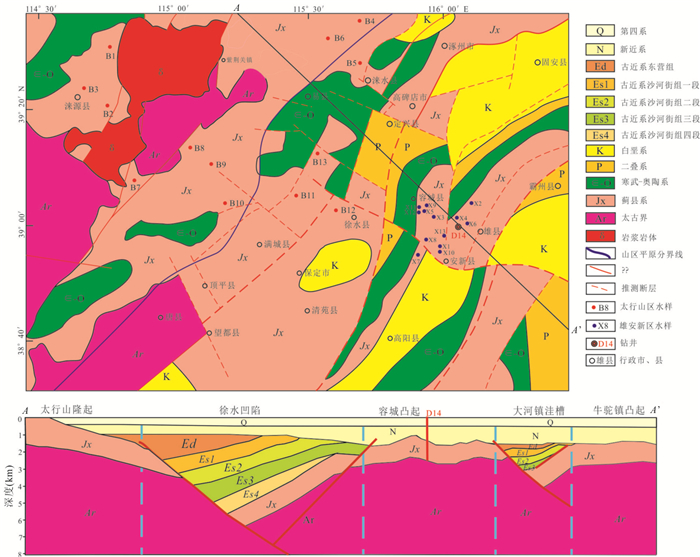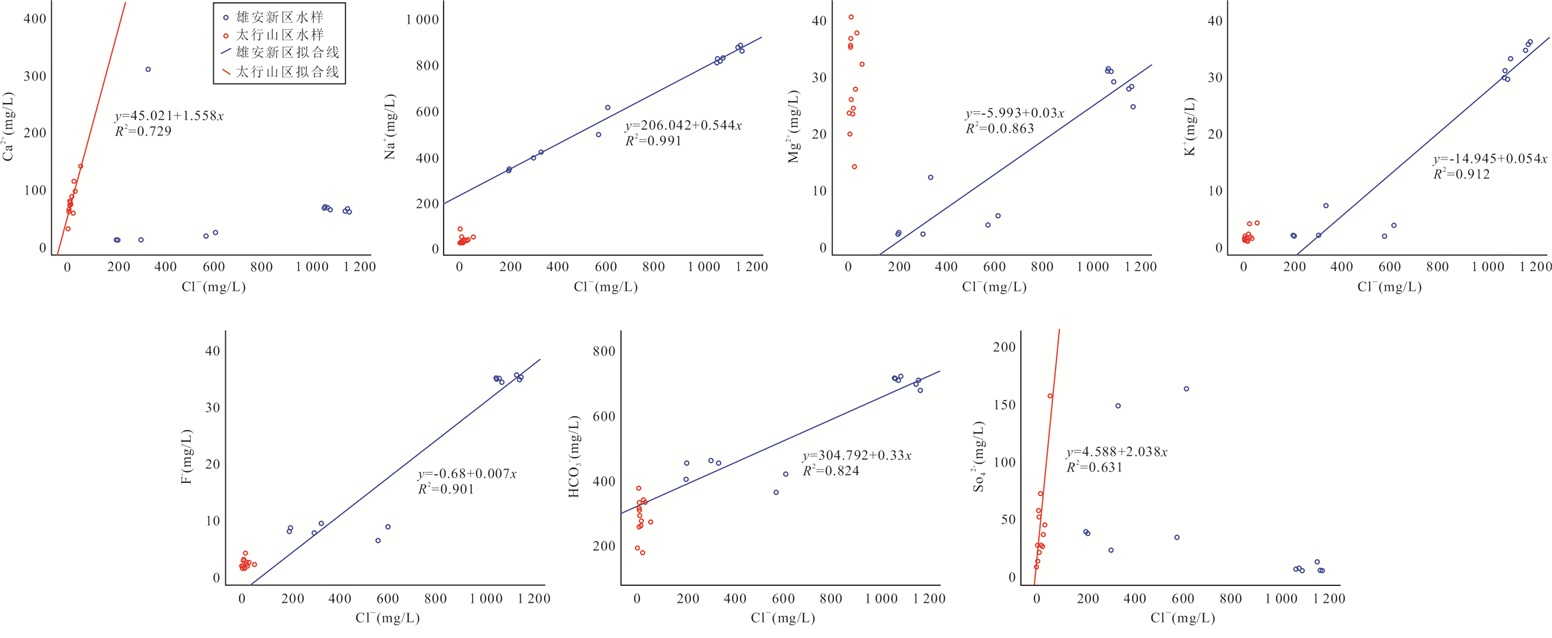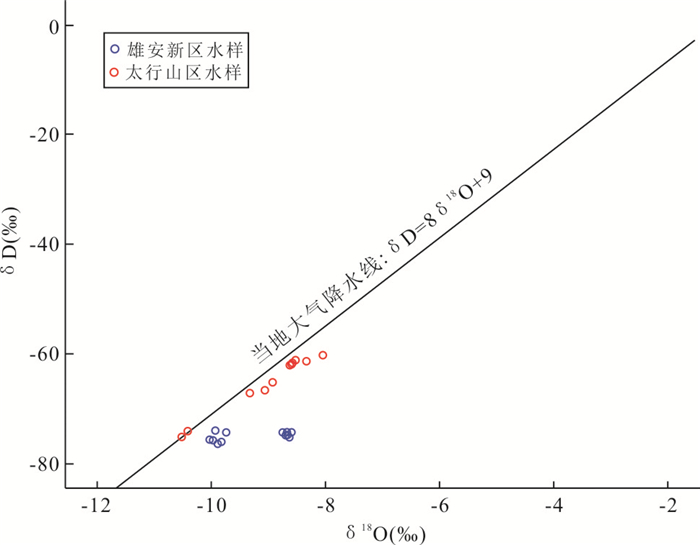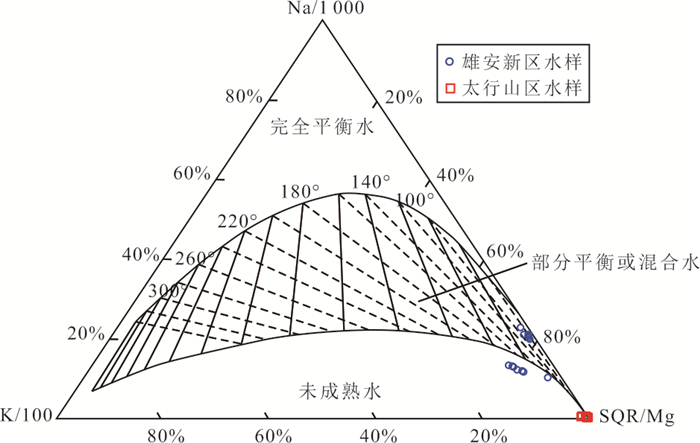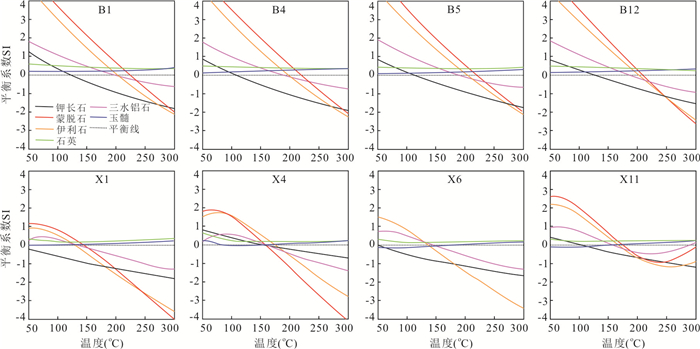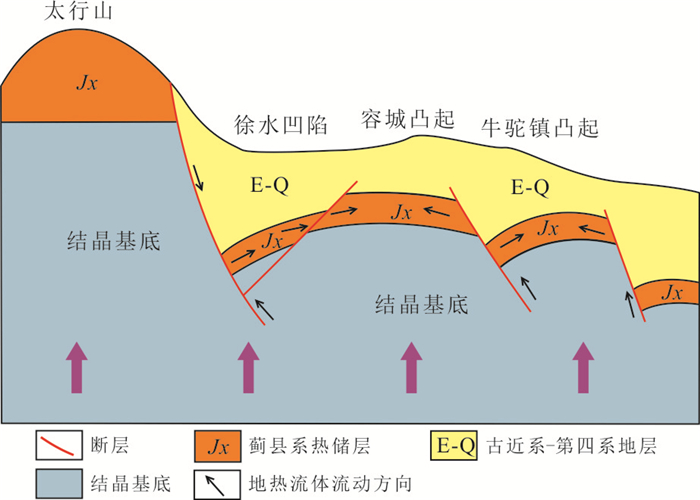Hydrogeochemistry of Geothermal Waters from Taihang Mountain-Xiong'an New Area and Its Indicating Significance
-
摘要: 雄安新区蓟县系雾迷山组热储层中具有丰富的中低温地热资源,研究其地热流体水文地球化学特征可分析地热资源的形成机制,对推动雄安新区深部地热资源有效开发利用具有重要意义.太行山区雾迷山组为基岩裸露区,雄安新区雾迷山组基底埋藏较深,两个系统的地热流体经历不同的水岩相互作用,导致水化学特征有一定差异.通过对保定以西太行山区-雄安新区共26组蓟县系雾迷山组地热流体样品的水化学及同位素数据进行分析,研究地热流体的补给来源及经历的深部地热循环过程.太行山区雾迷山组流体水化学类型以HCO3-Ca·Mg型为主,雄安新区以Cl·HCO3-Na型为主.地热流体均来源于大气降水,通过断裂、裂隙等通道入渗,在长距离运移过程中伴随有矿物的沉淀和溶解现象,水岩相互作用逐渐增强.深部热循环深度为2 880.26~4 143.42 m,均值为3 700 m,深部热储温度为160℃左右;地热流体在深部通过断裂上升过程中,由于传导冷却、冷水混入及深部热源通过结晶基底的热传导作用,在750~2 100 m的凸起处雾迷山组碳酸盐岩地层中封闭聚集形成热储层,热储平均温度为70℃左右,属于对流-传导型地热系统.Abstract: There are abundant geothermal resources in Wumishan Formation of Jixian system in Xiong'an New Area. The study of the hydrogeochemical characteristics of geothermal water can be used to analyze the mechanism of geothermal resources, which is of great significance in the deep of Xiong'an New Area. Based on the analysis of hydrochemical and isotopic data that tested from 26 geothermal water samples of Wumishan Formation in Taihang Mountain-Xiong'an New Area, this paper studies the source of geothermalwater supply and cyclic process of deep geothermal. The results show that HCO3-Ca·Mg is the main hydrochemical type of geothermal water in Taihang Mountain, while Cl·HCO3-Na is the main hydrochemical type in Xiong'an New Area. The geothermal water infiltrates through faults and fractures, accompanied by mineral precipitation and dissolution in the process of long-distance migration, and the interaction between water and rock gradually increases. The depth of deep thermal cycle is 2 880.26-4 143.42 m, with an average value of 3 700 m, and the temperature of deep thermal reservoir is about 160 ℃. The average temperature (lower limit temperature) of thermal reservoir at 750-2 100 m is about 70 ℃ due to the effect of conduction cooling and mixing of 42%-67% cold water during the deep rise of geothermal water.It belongs to convection-conduction geothermal system.
-
Key words:
- Xiong'an New Area /
- geothermal /
- hydrogeochemistry /
- hydrogen-oxygen isotope /
- hydrogeology
-
表 1 研究区雾迷山组地下水化学主要指标测试结果
Table 1. Hydrochemical analysis data of the geothermal water in Xiong'an New Area
井号 pH K+ Na+ Ca2+ Mg2+ HCO3- Cl- SO42- F- TDS δD (‰) δ18O (‰) 14C年代(a B.P) 含量(mg/L) X1 8.31 2.13 370.92 5.31 1.51 447.31 308.71 18.71 1.46 1 193 -75.71 -9.94 ~43 500 X2 8.63 1.91 323.21 4.84 1.64 439.32 208.12 33.74 1.66 1 061 -73.85 -9.91 ~43 500 X3 6.94 48.24 804.83 57.53 28.23 706.60 1 101.01 1.15 6.90 2 832 -74.79 -8.66 ~43 500 X4 7.17 50.39 848.65 54.87 26.96 682.03 1 164.04 8.68 7.16 2 926 -74.21 -8.57 ~43 500 X5 7.31 52.10 857.71 58.80 27.39 694.32 1 175.08 1.57 7.02 2 960 -74.21 -8.64 ~43 500 X6 7.99 4.61 589.12 17.53 4.71 405.54 620.95 159.02 1.69 1 830 -74.21 -9.72 ~42 800 X7 8.72 1.76 472.53 12.22 3.10 349.01 580.94 30.21 1.19 1 424 -75.57 -10.00 ~34 020 X8 8.78 2.04 317.42 4.78 1.51 388.30 205.04 34.51 1.52 1 014 -76.28 -9.87 ~33 600 X9 7.20 45.02 800.80 62.86 30.58 700.52 1 079.07 < 0.20 7.02 2 799 -74.22 -8.72 ~43 500 X10 7.58 42.80 790.01 61.87 30.08 694.31 1 090.05 3.56 7.04 2 790 — — — X11 7.90 9.86 395.42 303.30 11.48 439.33 340.42 144.30 1.811 1 402 -75.86 -9.80 ~35 960 X12 7.71 43.13 780.71 60.71 30.13 700.52 1 076.02 2.48 7.05 2 769 — — — X13 6.99 52.64 835.03 53.75 23.85 662.44 1 182.06 1.33 7.09 2 908 -75.12 -8.61 ~43 500 B1 8.05 0.90 2.66 23.66 22.78 176.00 2.11 4.99 0.27 258 -74.00 -10.40 — B2 7.92 2.30 15.58 80.80 23.54 261.10 17.95 68.14 0.73 502 -67.00 -9.30 — B3 7.85 1.24 4.40 54.32 19.05 240.61 4.93 8.99 0.24 351 -75.00 -10.50 — B4 8.19 0.76 6.32 67.22 35.83 293.41 9.15 53.36 0.45 491 -65.00 -8.90 — B5 7.78 1.17 16.31 89.78 36.88 316.82 33.78 40.77 0.39 623 -62.00 -8.60 — B6 7.85 0.49 6.11 72.75 39.65 316.83 10.56 47.85 0.50 533 -61.00 -8.50 — B7 7.32 5.24 28.70 134.00 31.23 257.34 56.59 153.30 0.32 785 -61.93 -8.57 ~200 B8 7.71 4.99 11.04 51.48 13.33 162.33 23.73 22.07 0.40 332 -61.67 -8.56 ~3 890 B9 7.82 0.89 3.51 65.24 34.63 300.64 8.03 30.79 0.21 468 -66.45 -9.04 ~940 B10 7.69 0.70 9.02 70.64 25.18 276.51 11.32 17.03 0.27 458 -61.64 -8.40 ~810 B11 7.65 0.43 10.05 66.60 22.59 246.50 16.43 23.63 0.34 434 -61.13 -8.30 ~2 170 B12 7.48 1.87 28.76 57.87 34.26 360.71 7.30 23.13 0.47 544 -74.09 -10.30 ~19 130 B13 7.62 1.46 12.70 108.20 26.96 324.64 27.38 32.72 0.26 629 -60.03 -8.01 ~-300 表 2 研究区雾迷山组地热流体离子特征系数表
Table 2. Ion characteristic coefficient of geothermal water in Xiong'an New Area
井号 Na+ Cl- HCO3- SO42- 变质系数 含量(mmol/L) γNa+/γCl- γCl-/γHCO3- γSO42-/γCl- X1 16.13 8.70 7.33 0.19 1.85 1.19 2.24 X2 14.05 5.86 7.20 0.35 2.40 0.81 6.00 X3 34.99 31.01 11.58 0.01 1.13 2.68 0.04 X4 36.90 32.79 11.18 0.09 1.13 2.93 0.28 X5 37.29 33.10 11.38 0.02 1.13 2.91 0.05 X6 25.61 17.49 6.65 1.66 1.46 2.63 9.47 X7 20.54 16.36 5.72 0.31 1.26 2.86 1.92 X8 13.80 5.77 6.37 0.36 2.39 0.91 6.22 X9 34.82 30.39 11.48 0.00 1.15 2.65 0.01 X10 34.35 30.70 11.38 0.04 1.12 2.70 0.12 X11 17.19 9.59 7.20 1.50 1.79 1.33 15.68 X12 33.94 30.31 11.48 0.03 1.12 2.64 0.09 X13 36.30 33.30 10.86 0.01 1.09 3.07 0.04 B1 0.12 0.06 2.89 0.05 1.95 0.02 87.45 B2 0.68 0.51 4.28 0.71 1.34 0.12 140.38 B3 0.19 0.14 3.94 0.09 1.38 0.04 67.43 B4 0.27 0.26 4.81 0.56 1.07 0.05 215.65 B5 0.71 0.95 5.19 0.42 0.75 0.18 44.63 B6 0.27 0.30 5.19 0.50 0.89 0.06 167.56 B7 1.25 1.59 4.22 1.60 0.78 0.38 100.18 B8 0.48 0.67 2.66 0.23 0.72 0.25 34.39 B9 0.15 0.23 4.93 0.32 0.67 0.05 141.79 B10 0.39 0.32 4.53 0.18 1.23 0.07 55.63 B11 0.44 0.46 4.04 0.25 0.94 0.11 53.18 B12 1.25 0.21 5.91 0.24 6.08 0.03 117.17 B13 0.55 0.77 5.32 0.34 0.72 0.14 44.19 表 3 研究区地热温标估算值
Table 3. Calculation results of geothermal temperature in Xiong'an New Area
井号 SiO2地热温标(℃) 井号 SiO2地热温标(℃) 多矿物平衡法(℃) 硅-焓混合模型(℃) T石英 T玉髓 T石英 T玉髓 B1 70.73 38.96 X1 76.50 45.00 142 112 B2 51.53 19.07 X2 112.19 83.08 138 100 B3 39.81 7.08 X3 70.93 39.16 167 80 B4 44.34 11.70 X4 69.22 37.38 167 140 B5 60.14 27.94 X5 38.54 5.79 162 142 B6 43.50 10.85 X6 72.36 40.66 150 100 B7 70.93 39.16 X7 103.31 73.50 128 109 B8 69.22 37.38 X8 79.10 47.74 121 99 B9 37.30 4.54 X9 99.71 69.63 153 127 B10 55.90 23.57 X10 40.91 8.20 158 128 B11 55.97 23.63 X11 45.00 12.37 163 132 B12 81.55 50.32 X12 70.73 38.96 160 126 B13 71.81 40.08 X13 55.97 23.63 169 146 保定山区
热储温度均值54.91 22.61 雄安新区
热储温度均值97.45 67.32 157 128.38 表 4 雄安新区热储热循环深度计算结果
Table 4. Calculation results of thermal cycle depth in Xiong'an New Area
井号 热储平均温度/下限温度(℃) 热循环深度(m) 深部热储温度(℃) 最终热循环深度(m) X1 47.74 952.32 142 3 432.89 X2 43.14 831.29 138 3 327.63 X3 73.50 1 630.17 167 4 090.79 X4 85.82 1 954.49 167 4 090.79 X5 83.08 1 882.45 162 3 959.21 X6 42.01 801.58 150 3 643.42 X7 45.00 880.21 128 3 064.47 X8 40.66 766.09 121 2 880.26 X9 72.43 1 602.12 153 3 722.37 X10 72.32 1 599.24 158 3 853.95 X11 45.85 902.51 163 3 985.53 X12 69.63 1 528.46 160 3 906.58 X13 89.77 2 058.42 169 4 143.42 均值 67.32 1 337.64 157 3 700.10 表 5 反向地球化学模拟计算结果表
Table 5. Results of reverse hydrogeochemical simulation
反应路径 方解石 白云石 高岭石 伊利石 钙长石 石膏 岩盐 B1-X1 -7.641×10-1 -3.487×10-3 -7.643×10 -5.214×10-5 3.867×10 7.073×10-5 8.484×10-3 注: 表中“+”表示矿物溶解;“-”表示矿物的沉淀;单位为mmol/kg H2O -
Arnorsson, S., Andresdotir, A., 1995. Processes Controlling the Distribution of Boron and Chlorine in Natural Waters in Iceland. Geochimica et Cosmochimica Acta, 59(20): 4125-4146. https://doi.org/10.1016/0016-7037(95)00278-8 Chen, M.X., 1988. Geothermal Resources in North China. Science Press, Beijing, 1-214 (in Chinese). Chen, M.X., Wang, J.Y., Wang, J.A., et al., 1990. The Characteristics of the Geothermal Field and Its Formation Mechanism in the North China Down-Faulted Basin. Acta Geologica Sinica, (1): 80-91 (in Chinese with English abstract). http://en.cnki.com.cn/Article_en/CJFDTOTAL-DZXE199001007.htm Fournier, R.O., Truesdell, A.H., 1973. An Empirical Na-K-Ca Geothermometer for Natural Waters. Geochimica et Cosmochimica Acta, 37(5): 1255-1275. doi: 10.1016/0016-7037(73)90060-4 Giggenbach, W. F., 1988. Geothermal Solute Equilibria. Derivation of Na-K-Mg-Ca Geoindicators. Geochimica et Cosmochimica Acta, 52(12): 2749-2765. https://doi.org/10.1016/0016-7037(88)90143-3 Kong, Y. L., Pang, Z. H., Pang, J. M., et al., 2017. Stable Isotopes of Deep Groundwater in the Xiongxian Geothermal Field. Procedia Earth and Planetary Science, 17: 512-515. https://doi.org/10.1016/j.proeps.2016.12.129 Lang, X.J., Lin, W.J., Liu, Z.M., et al., 2016. Hydrochemical Characteristics of Geothermal Water in Guide Basin. Earth Science, 41(10): 1723-1734 (in Chinese with English abstract). Li, C.S., Wu, X.C., Sun, B., et al., 2018. Hydrochemical Characteristics and Formation Mechanism of Geothermal Water in Northern Ji'nan. Earth Science, 43(Suppl.1): 313-325 (in Chinese with English abstract). http://en.cnki.com.cn/Article_en/CJFDTotal-DQKX2018S1027.htm Li, J.X., Guo, H.Q., Yu, Z.Y., 2017. Impact of Clay Mineral Formation in High-Temperature Geothermal System on Accuracy of Na-K and K-Mg Gethermameters. Earth Science, 42(1): 142-154 (in Chinese with English abstract). Liu, J.R., Song, X.F., Yuan, G.F., et al., 2009. Characteristics of δ18O in Precipitation over Eastern Monsoon China and the Water Vapor Sources. Chinese Sci. Bull. , 54(22)3521-3531 (in Chinese with English abstract). doi: 10.1360/csb2009-54-22-3521 Liu, M.L., He, T., Wu, Q.F., et al., 2020. Hydrogeochemistry of Geothermal Waters from the Xiong'an New Area and Its Indicating Significance. Earth Science, 45(6): 2221-2231 (in Chinese with English abstract). Pang, J. M., Pang, Z. H., Lü, M., et al., 2017. Geochemical and Isotopic Characteristics of Fluids in the Niutuozhen Geothermal Field, North China. Environmental Earth Sciences, 77(1): 1-21. https://doi.org/10.1007/s12665-017-7171-y Qin, L.H., Shi, X.J., Yu, Y., et al., 2019. Geochemical Characteristics of Geothermal Fluid in the Wumishan Formation of Jixian System in Tianjin. Contributions to Geology and Mineral Resources Research, 34(1): 150-154 (in Chinese with English abstract). http://en.cnki.com.cn/Article_en/CJFDTotal-DZZK201901020.htm Reed, M., Spycher, N., 1984. Calculation of PH and Mineral Equilibria in Hydrothermal Waters with Application to Geothermometry and Studies of Boiling and Dilution. Geochimica et Cosmochimica Acta, 48(7): 1479-1492. https://doi.org/10.1016/0016-7037(84)90404-6 Sanchez Navarro, J. A., Lopez, P. C., Perez-Garcia, A., 2004. Evaluation of Geothermal Flow at the Springs in Aragon (Spain), and Its Relation to Geologic Structure. Hydrogeology Journal, 12(5): 601-609. https://doi.org/10.1007/s10040-004-0330-8 Shen, Z.L., Zhu, W.H., Zhong, Z.S., 1983. Basis of Hydrogeochemical. Geosciences Press, Beijing (in Chinese). Song, X.Q., Peng, Q., Duan, Q.S., et al., 2019. Hydrochemistry Characteristics and Origin of Geothermal Water in Northeastern Guizhou. Earth Science, 44(9): 2874-2886 (in Chinese with English abstract). http://en.cnki.com.cn/Article_en/CJFDTotal-DQKX201909006.htm Sorey, M. L., Colvard, E. M., 1997. Hydrologic Investigations in the Mammoth Corridor, Yellowstone National Park and Vicinity, U.S.A. . Geothermics, 26(2): 221-249. https://doi.org/10.1016/s0375-6505(96)00041-7 Stanley, W. D., 1982. Geothermal Systems, Principles and Case Histories. Earth-Science Reviews, 18(1): 91-92. https://doi.org/10.1016/0012-8252(82)90020-4 Sun, Y., Zhou, J. L., Wei, X., et al., 2019. Hydrochemical Characteristics and Cause Analysis of Groundwater in the Plain Area of Bachu County. Environmental Chemistry, 38(11): 1-9 (in Chinese with English abstract). Sun, Z.X., Li, X. L., Shi, W.J., 1992. Isotopic Hydrogeochemistry of Mid-Low Temperature Geothermal Water in Jiangxi Province. Journal of East China Geological Institute, 15(3): 243-248 (in Chinese with English abstract). http://en.cnki.com.cn/Article_en/CJFDTOTAL-HDDZ199203004.htm Wang, D. C., Zhang, R. Q., Shi, Y. L., et al., 1986. General Hydrogeology. Geosciences Press, Beijing (in Chinese). Wang, G. L., Zhang, W., Lin, W.J., et al., 2017. Research on Formation Mode and Development Potential of Geothermal Resources in Beijing-Tianjin-Hebei Region. Geology in China, 44(6): 1074-1085 (in Chinese with English abstract). http://www.researchgate.net/publication/324014114_Research_on_formation_mode_and_development_potential_of_geothermal_resources_in_Beijing-Tianjin-Hebei_region Wang, J. Y., 1996. Low-Medium Temperature Geothermal System of Convective Type. Earth Science Frontiers, 3(3-4): 96-102 (in Chinese with English abstract). http://en.cnki.com.cn/Article_en/CJFDTOTAL-DXQY603.010.htm Wang, W. L., Wang, G. L., Zhu, X., 2016. Method of Forecasting the Temperature in Constant Temperature Zone under Warm Temperate Climates. Renewable Energy Resources, 34(8): 1112-1116 (in Chinese with English abstract). http://www.zhangqiaokeyan.com/academic-journal-cn_renewable-energy-resources_thesis/0201228480955.html Wang, S. Q., 2017. Hydrogeochemical Processes and Genesis Machenism of High-Temperature Geothermal System in Gudui, Tibet. China University of Geosciences, Beijing (in Chinese with English abstract). Wu, H. M., Sun, Z. X., 2000. Calculation of the Fluid-Rock Equilibrium State in the Geothermal System. Journal of East China Geological Institute, 23(1): 39-42 (in Chinese with English abstract). http://en.cnki.com.cn/Article_en/CJFDTOTAL-HDDZ200001008.htm Xu, W. C., 1992. Application of the Saturation Index Method to the Study of Geothermal Geochemistry. Journal of Xi'an College of Geology, 14(3): 66-70 (in Chinese with English abstract). http://en.cnki.com.cn/Article_en/CJFDTOTAL-XAGX199203011.htm Yan, X. X., Gan, H. N., Yue, G. F., 2019. Hydrogeochemical Characteristics and Genesis of Typical Geothermal Fields from Huangshadong to Conghua in Guangdong. Geological Review, 65(3): 743-754 (in Chinese with English abstract). http://en.cnki.com.cn/Article_en/CJFDTotal-DZLP201903020.htm Zhai, M. G., 2019. Tectonic Evolution of the North of China Craton. Journal of Geomechanics, 25(5): 722-745 (in Chinese with English abstract). http://en.cnki.com.cn/Article_en/CJFDTotal-DZLX201905008.htm Zhang, B. J., 2011. Hydrogeochemical Characteristics and Formation Conditions of the Geothermal Water in Northwestern Shandong Province. China University of Geosciences, Beijing (in Chinese). Zhao, J. Y., Zhang, W., Zhang, H. X., et al., 2019. Hydrogeochemical Characteristics and Genesis of the Geothermal Fields in Batang of Sichan. Hydrogeology & Engineering Geology, 46(4): 81-89 (in Chinese with English abstract). http://en.cnki.com.cn/Article_en/CJFDTotal-SWDG201904012.htm 陈墨香, 1988. 华北地热. 北京: 科学出版社, 1-214. 陈墨香, 汪集暘, 汪缉安, 等, 1990. 华北断陷盆地热场特征及其形成机制. 地质学报, (1): 80-91. https://www.cnki.com.cn/Article/CJFDTOTAL-DZXE199001007.htm 郎旭娟, 蔺文静, 刘志明, 等, 2016. 贵德盆地地下热水水文地球化学特征. 地球科学, 41(10): 1723-1734. doi: 10.3799/dqkx.2016.509 李常锁, 武显仓, 孙斌, 等, 2018. 济南北部地热水水化学特征及其形成机理. 地球科学, 43(增刊1): 313-325. doi: 10.3799/dqkx.2018.206 李洁祥, 郭清海, 余正艳, 2017. 高温地热系统中黏土矿物形成对Na-K和K-Mg地球化学温标准确性的影响. 地球科学, 42(1): 142-154. doi: 10.3799/dqkx.2017.011 柳鉴容, 宋献方, 袁国富, 等, 2009. 中国东部季风区大气降水δ18O的特征及水汽来源. 科学通报, 54(22): 3521-3531. https://www.cnki.com.cn/Article/CJFDTOTAL-KXTB200922015.htm 刘明亮, 何潼, 吴启帆, 等, 2020. 雄安新区地热水化学特征及其指示意义. 地球科学, 45(6): 2221-2231. doi: 10.3799/dqkx.2019.270 秦莉红, 石晓金, 于彦, 等, 2019. 天津市蓟县系雾迷山组地热流涕地球化学特征. 地质找矿论丛, 34(1): 150-154. 沈照理, 朱宛华, 钟佐燊, 1983. 水文地球化学基础. 北京: 地质出版社. 宋小庆, 彭钦, 段启杉, 等, 2019. 黔东北地区地热水化学特征及起源. 地球科学, 44(9): 2874-2886. doi: 10.3799/dqkx.2019.146 孙英, 周金龙, 魏兴, 等, 2019. 巴楚县平原区地下水水化学特征及成因分析. 化学环境, 38(11): 1-9. https://www.cnki.com.cn/Article/CJFDTOTAL-HJHX201911022.htm 孙占学, 李学礼, 史维浚, 1992. 江西中低温地热水的同位素水文地球化学. 华东地质学院学报, 15(3): 243-248. https://www.cnki.com.cn/Article/CJFDTOTAL-HDDZ199203004.htm 王大纯, 张人权, 史毅虹, 等, 1986. 水文地质学基础. 北京: 地质出版社. 王贵玲, 张薇, 蔺文静, 等, 2017. 京津冀地区地热资源成藏模式与潜力研究. 中国地质, 44(6): 1074-1085. https://www.cnki.com.cn/Article/CJFDTOTAL-DIZI201706004.htm 汪集暘, 1996. 中低温对流地热系统. 地学前缘, 3(3-4): 96-102. 王思琪, 2017. 西藏古堆高温地热系统水文地球化学过程与形成机理(博士毕业论文). 北京: 中国地质大学. 王婉丽, 王贵玲, 朱喜, 2016. 暖温带地区恒温层温度的预测方法. 可再生能源, 34(8): 1112-1116. https://www.cnki.com.cn/Article/CJFDTOTAL-NCNY201608002.htm 吴红梅, 孙占学, 2000. 地热系统中矿物-流体化学平衡的计算. 华东地质学院学报, 23(1): 39-42. doi: 10.3969/j.issn.1674-3504.2000.01.009 许万才, 1992. 饱和指数法在地下热水化学研究中的应用. 西安地质学院学报, 14(3): 66-70. https://www.cnki.com.cn/Article/CJFDTOTAL-XAGX199203011.htm 闫晓雪, 甘浩男, 岳高凡, 2019. 广东惠州-从化典型地热田水文地球化学特征及成因分析. 地质论评, 65(3): 743-754. https://www.cnki.com.cn/Article/CJFDTOTAL-DZLP201903020.htm 翟明国, 2019. 华北克拉通构造演化. 地质力学学报, 25(5): 722-745. https://www.cnki.com.cn/Article/CJFDTOTAL-DZLX201905008.htm 张保健, 2011. 鲁西北地区地下热水的水文地球化学特征及形成条件研究(博士毕业论文). 北京: 中国地质大学. 赵佳怡, 张薇, 张汉雄, 等, 2019. 四川巴塘地热田水文地球化学特征及成因. 水文地质工程地质, 46(4): 81-89. https://www.cnki.com.cn/Article/CJFDTOTAL-SWDG201904012.htm -









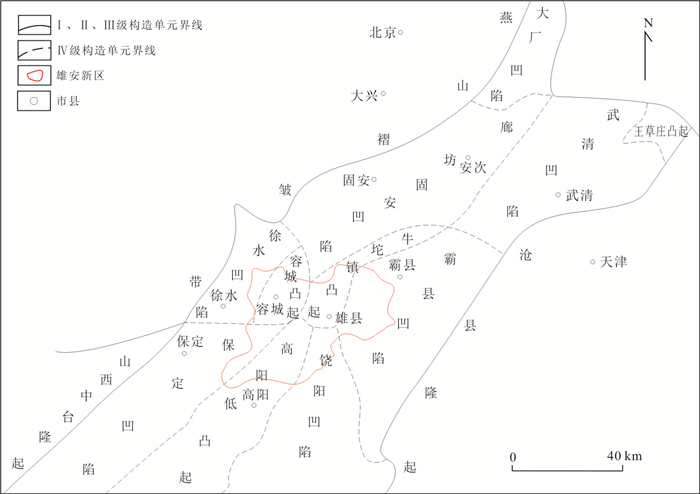
 下载:
下载:
